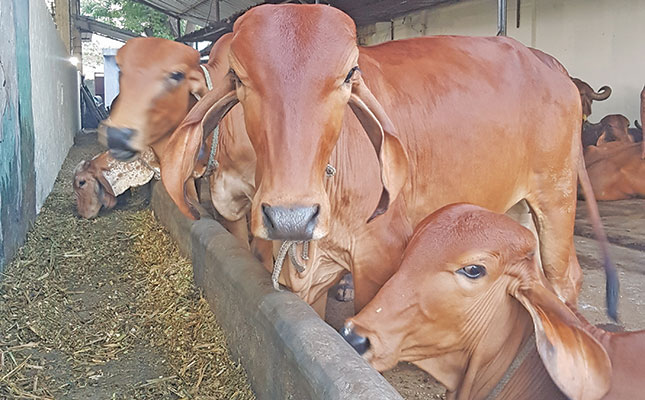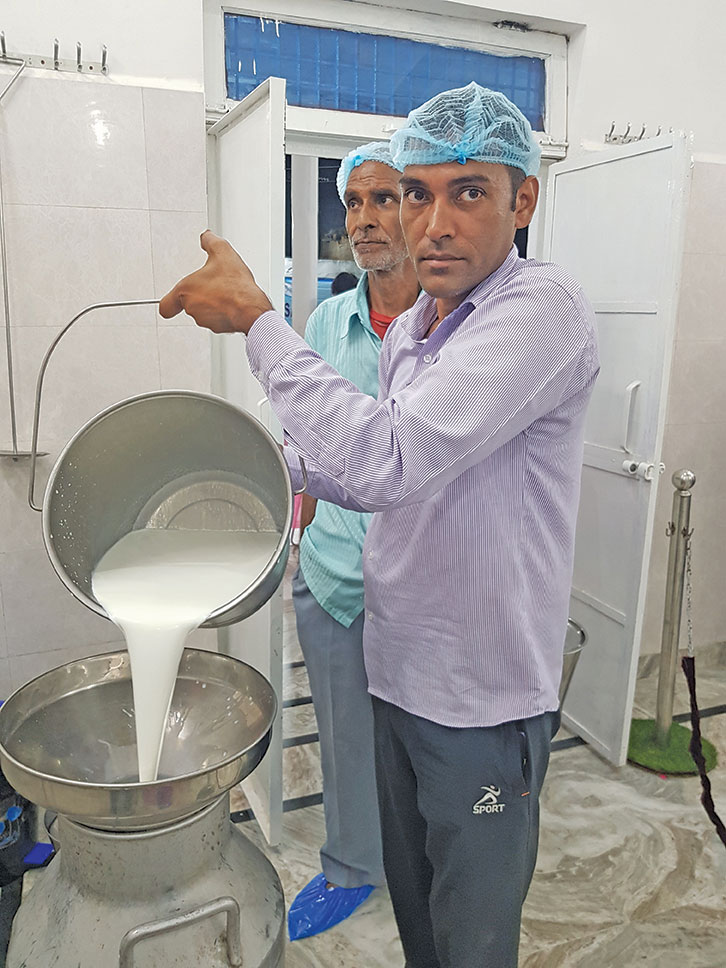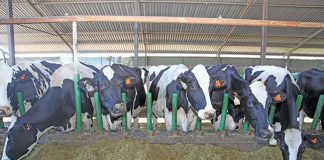
Photo: Lindi Botha
In the 1950s, India had the world’s lowest per capita consumption of milk, despite the fact that the country had the largest cattle herd.
The irony was not lost on social entrepreneur Dr Verghese Kurien, who approached the Indian government with an idea that would become known as the White Revolution, and one that would transform India into the dairy powerhouse it is today.
Kurien recognised the treasure that lay in most backyards across the country. Hindus hold cattle in high esteem and although they do not eat beef, they do drink milk. Most rural households therefore keep cattle both for religious and food- security purposes. Kurien realised that if these households were able to sell any excess milk they didn’t consume, the cows could simultaneously become sources of income for masses of rural Indians while boosting national milk supplies.
During the 1960s, farmers were provided with improved genetics to boost their production. The National Dairy Development Board was established and a national milking grid linking millions of farmers to households was created so that milk could be sold directly to consumers.
This eliminated seasonal fluctuations in milk prices, and provided farmers with a transparent pricing system, as there were no middlemen.
As a result, India not only became self-sufficient in dairy, but is now the biggest producer of milk in the world.
Growth in demand
The country’s per capita milk consumption increased from 130g/person/day in 1950 to 427g/person/day in 2021, and is expected to reach 825g/person/day by 2047.
Milk production is expected to continue on its upward trajectory, so this higher demand will in no way put a dent in exports. Instead, India is forecast to have an annual milk surplus of 111 million tons by 2047, which they will be able to export. This will take up a sizeable chunk of the 149 million tons of milk that will comprise global trade in 25 years’ time.
The growth in demand for milk hasn’t come about organically, and the industry has invested in many a marketing campaign to encourage the consumption of milk in all its forms.
Indian cuisine by nature includes a lot of dairy (paneer, ghee, milk tea and raita serve as examples), but the trend towards Western fare such as pizza, ice cream and cheeseburgers is also bolstering demand. This bodes well for an industry that supports numerous poor households.
Small, but not insignificant
The rise of India’s dairy sector is testament to what can be achieved through the large-scale co-operation of millions of individuals. While each household might only be adding a drop to the collective milk bucket, the view that every drop counts is what has seen this bucket overflow.
Of course, the White Revolution would not have been possible without the collaboration between the government and the private sector, and it is this partnership that has sustained the industry all this time.
Prime Minister of India Narendra Modi has been an enthusiastic proponent of the system, calling small-scale farmers “the backbone” of the country’s dairy production.
“The whole system is sustainable because there are so many farmers involved. The co-operatives are present in over 200 000 villages, so there is no middleman, and 70% of the income from the milk can go back into the pockets of the farmers, keeping them sustainable.
“Our system shows that dairy can become a lifeline for farmers in poor countries, and if it can work here, it can work anywhere,” says Modi.
Since there are so many co-operatives, most households that own a cow are within walking distance of delivery points. The milk is collected and transported in silver cans and is only cooled once it reaches a milk pooling point (MPP).
Ajay Ohri, deputy chief executive of Saahaj Milk Producer Company in Agra, says that since milk only begins to spoil within about three hours of leaving the cow’s udder, it reaches the MPPs in good condition.
Although the milk yield per cow is low when compared with commercial standards, at around 6ℓ/day, it is still much more than what can be consumed by each household every day.
Farmers take what they need and deliver the rest to the MPP twice daily. Upon arrival here, the milk is tested for bacteria and antibiotics, and the butterfat content is established, as farmers are paid according to the percentage of butterfat present. (On average, the farmers receive about R11/ℓ.) The milk is then cooled.

The data is captured on the system, and the farmers are immediately sent notifications via an app on their phones, detailing what has been delivered, and the payments that are due to them.
Financial freedom
Around 85% of the price paid for milk by the consumer in India goes back to the farmers. Through this system, 6,9 million women have achieved economic independence. Aside from collecting the milk, the co-operatives also play a crucial role in improving India’s dairy sector, since most offer farmer training, as well as veterinary, artificial insemination (AI) and feed services.
Ohri explains that there is one MPP for every five to seven villages, depending on the breedable population of cows in each. An AI centre is established in a key village, and it is from here that a qualified and trained AI technician provides services to the surrounding villages.
A veterinarian is also positioned to serve a group of villages, monitoring cow health, conception rates, farmer training, and compliance with laws and regulations, as well as ensuring the continual improvement of production.
Ohri says that one of the biggest challenges the farmers face is providing sufficient feed for their cows, as most households don’t have enough land on which to grow fodder.
“We therefore run silage-making courses in the villages, but also provide farmers with feed and concentrate mixes to boost their productivity.
“With better feed, farmers can bring down the cost of milk production and improve health and reproduction efficiency, so feed is a key area that we are always looking to improve,” he adds.
An efficient value chain
A milk system like India’s requires a highly functional value chain. Several mammoth dairy plants are scattered across the country, one of which is Mother Dairy in Delhi, which was commissioned in 1974 and can process five million litres of milk, pooled from around 700 000 farmers, every day. The milk and milk-based products, such as lassi and paneer, are then distributed via a network of home deliveries, vending machines and stores.
Maintaining consistent production is a challenge in a system where farmers are neither bound by contracts to deliver milk, nor compelled to deliver a certain volume. Instead, farmers are incentivised to achieve certain targets, explains Manish Goyal, general manager of operations at Mother Dairy.
“Farmers will always keep some of their milk back for home use. Nonetheless, we need as much milk as possible to meet our own production targets. Through data collected via the milk-delivery app, we can get a good idea of how much milk we’ll receive each day. If farmers deliver more, they get a bonus.
“The app also assists us with managing our logistics, because we can see how much milk needs to be transported to the main dairy plants, so we can send the right-sized milk trucks to the villages,” he says.
The only cost to farmers is a small once-off joining fee when registering with a co-operative. They receive annual bonuses of between 6% and 10% of their income, based on the additional profit that the milk company was able to achieve throughout the year.
Many co-operatives have also started their own ranges of value-added products, producing ghee and paneer to increase their income.
Sustainability
While India’s dairy industry has much to boast about, its sustainability and impact on the environment are thorns in its side.
As far as greenhouse gases (GHGs) go, India is one of the world’s largest sources of methane emissions produced by dairy cattle, mostly because of the lower productivity per cow. Increasing productivity and feed efficiency is therefore an area that is receiving greater focus.
However, as Modi puts it, sustainability can only happen when stomachs are full. “Farmers don’t worry about sustainability when they’re struggling to feed their families, and consumers are the same. Only when we get Indian dairy farmers to sustainable levels of profitability, will they start concentrating on the environment.”
To this end, the government is focusing on improving production by offering universal vaccination programmes, specifically for foot-and-mouth and lumpy skin disease. For the latter, a locally developed vaccine was released this year and is expected to make a big dent in the high incidence of this disease in India.
Single-use plastic also poses a big problem for cattle, since many of these animals roam the streets freely, and end up choking on plastic as they pick up scraps in the veld. In July 2022, India imposed a ban on certain categories of single-use-plastic items. This will help prevent the piling up of rubbish and will, in turn, benefit the livestock industry.
The ingenuity of the Indian nation has not bypassed the dairy industry. Cow dung and urine are being developed into full standalone product streams that have the potential to provide farmers with significant additional income. As it stands, more than 1 000 start-ups are making money from these products.
Hetha organics
One dairy farm on the outskirts of Delhi is taking another approach to sustainability. Hetha Organics is a certified-organic farm that, along with milk and other dairy items, sells value-added products to remain profitable.
While the organic production is an added cost in itself, the company also follows an ‘ethical milking’ system in which no animals are slaughtered, and only two of the four teats are milked, leaving the remaining two for the calves. This results in a marketable yield of 5ℓ/cow/day.
Bull calves are either kept for breeding or raised as bullocks to be used on the farm instead of tractors, and older cows that no longer provide milk are kept until they die of natural causes.
“If we only relied on income from milk, we wouldn’t be able to sustain the business. By selling value-added products, we’ve been profitable for the last seven years,” explains Aseem Rawat, CEO of Hetha Organics.
Cow manure is composted and spread on the fields where fodder and grain crops are grown. A portion of the grain is sold under an organic label, and the rest is fed to Hetha’s 800 head of cattle. Cow dung is used to make a variety of products, including sculpted statuettes of Hindu deities, and dung cakes that can be burnt like charcoal for heating purposes.
Hetha also has a pharmaceutical licence to make health products for Ayurvedic medicine, a form of complementary medicine widely used in India, and processes cow urine to produce such items.
To supplement their feed, the cows in milk also receive hydroponically grown fodder, since land on which to grow crops is scarce. Barley, maize, oats and legumes are grown in a climate-controlled container, resulting in an additional 220kg of feed per day. These crops are irrigated with recycled water.
Thanks to the concerted collaborative efforts of the government and the private sector, the White Revolution has changed the lives of millions of small-scale farmers in India.
While optimising efficiency and reducing GHG emissions are issues that still need to be addressed, the Indian model offers a lesson to other countries in which rural populations are marginalised, despite having valuable resources that could aid food security.











